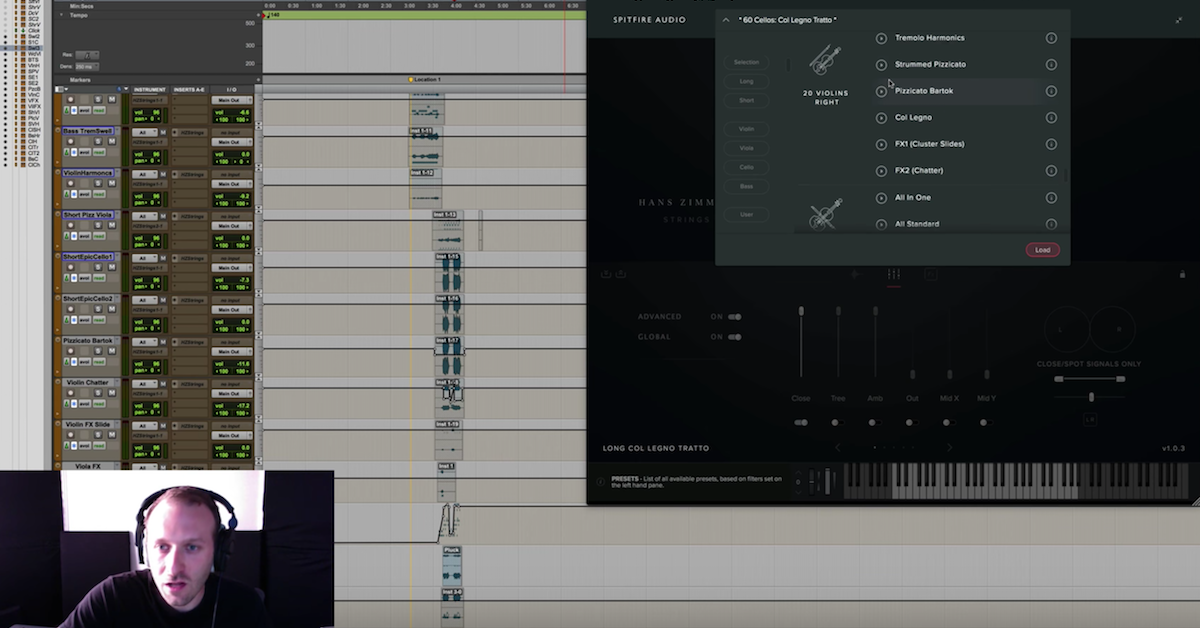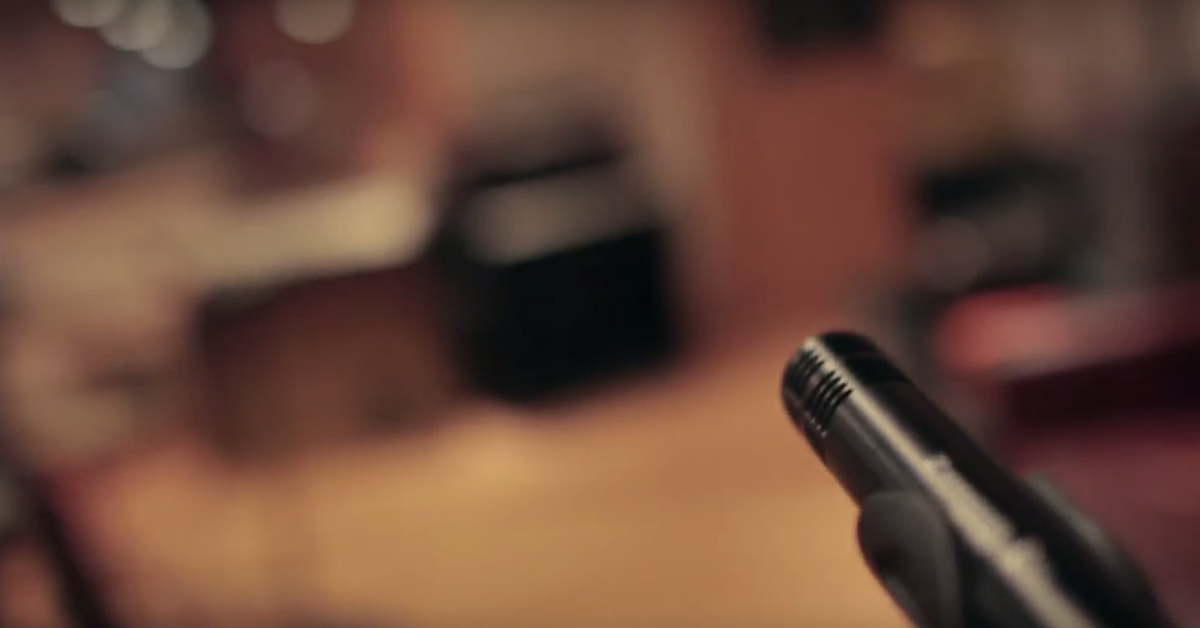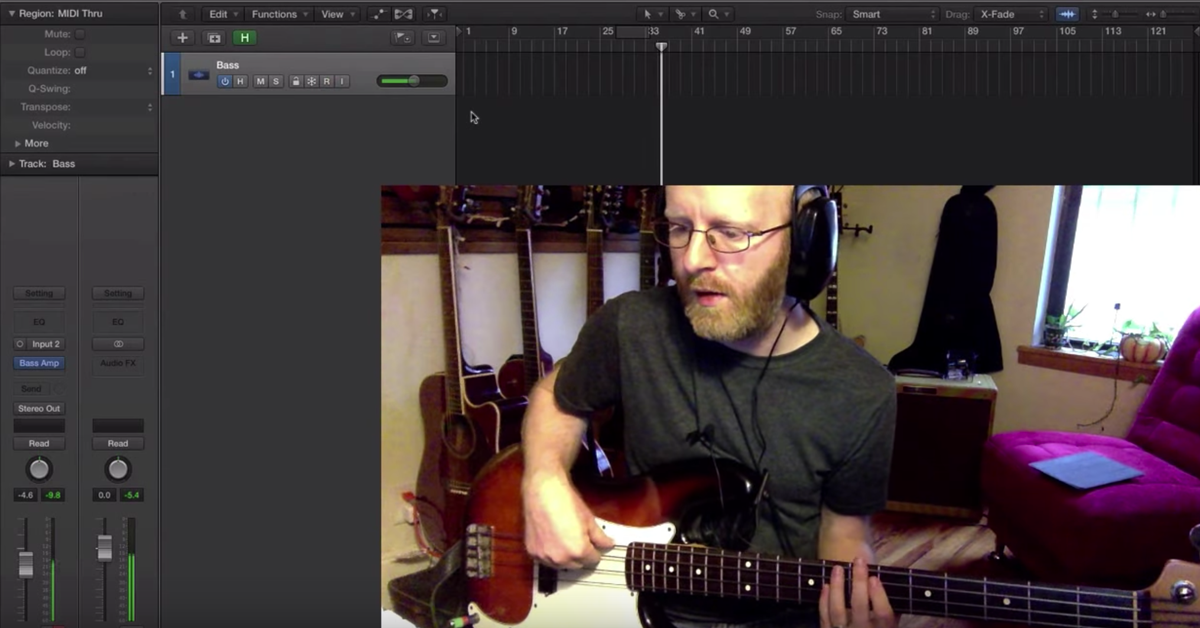9 Tips for Recording Strings
Article Content
There’s really nothing like the way a great string arrangement can elevate a recording of a song. Even though I’m a string player, I stand by that last sentence as a statement of objective fact, and not my own (very biased) opinion. Prove me wrong!
Sample libraries have provided a way to add strings to productions on even the tightest budgets, but I’m a firm believer that there’s a certain intangible quality that we can only get by bringing real players into a studio — even a modest studio — to make a unique recording. I’m not knocking string samples. They have their place. But you may very well find yourself wanting to add live strings to a recording and realize that they present a new set of challenges compared to recording typical rock band instruments.
In this article, we’ll look at some ways to get the most out of a session with live string players, even if you have to record them in a home studio. Let’s start with a big one:
1. Consider the Room
More than many other instruments, we’re used to hearing strings at a distance — whether it’s in a concert hall or on a recording. For that reason, it’s best to record string instruments in a room that will allow spacious microphone placements whenever possible.
In a commercial studio, this is no problem. When recording in a more DIY setting, it’s important to use the best sounding room you have available. If you’re recording at home, find the room that sounds best and put your string player(s) in there. Wooden surfaces and high ceilings are a major plus, allowing the recording to sound spacious and open with fewer of the problems you might encounter when recording at home.
If you don’t have a spacious or beautiful sounding room to work in, don’t stress — but keep in mind that far placements will probably be more headache than they’re worth. Use some of the closer, more basic mic placements we’ll look at later, and use reverb to add space in the mix.
2. Ask Yourself: How Big of a String Sound?
Not all string arrangements are created equal. Many pop string parts are small and tight — a few players, not much ambience. Curtis Mayfield’s “Move on Up” is a classic example — just a few violins play together as a unit:
Other songs might feature “midsized” strings, like a quartet or chamber ensemble. T Rex’s “Cosmic Dancer” has a string part that fits into this category, with interlocking violin, viola and cello parts:
More cinematic string parts tend to feature more players, and will sound more natural in a larger space. You can hear an orchestral string section on Lana Del Rey’s version of “Blue Velvet:”
There is more than one way to record strings, and the type of string recording you’re making will inform your other choices. Have a vision in mind before you set up mics, and good string players will do the work of making the part sound good.
3. Color the Sound With Mic Choice
The microphones you use can contribute hugely to the recorded string sound. In a good sounding room with good string players, mic selection and placement will go a long way toward defining the sound you get before any kind of processing is added.
Condenser mics are a common choice for strings, and will yield a glossy, detailed sound. Large diaphragm condensers will more accurately reproduce the full range of lower string instruments like cello and bass. They tend to have wider pickup patterns, so they’ll capture more of the room. Small diaphragm condensers are more directional and can make great “spot mics” for higher string instruments (violin and viola) as well as working well for spacious stereo placements.
Ribbon mics are favored by many recordists because of their smooth, natural sound. They tame some of the shrillness that can happen with instruments like violin, and they are generally very forgiving. Their figure-8 pickup pattern means that they will capture the room from behind along with the direct sound in front. Figure-8 mics reject sound from the side, creating possibilities for better isolation when close miking instruments in an ensemble.
Dynamic mics tend not to be the best choice for recording string instruments, though they can work in a pinch. Larger dynamic mics, like the Shure SM7B and Electro Voice RE20, are often solid choices for cello and upright bass.
4. Use Far Placements to Capture the Sound of the Players and the Room
Whether recording a soloist, a quartet or a larger string section, try starting with a distant placement that captures the natural sound in the room. For a soloist or small group, a well-placed single mic can yield a satisfying mono recording. Stereo setups like X/Y, Blumlein, mid/side and spaced pairs — as well as specialized setups like the Decca tree (essentially a three-mic left, center, right setup using omnidirectional mics) — can produce wider, more panoramic recordings that capture the sound of the space and the ensemble.
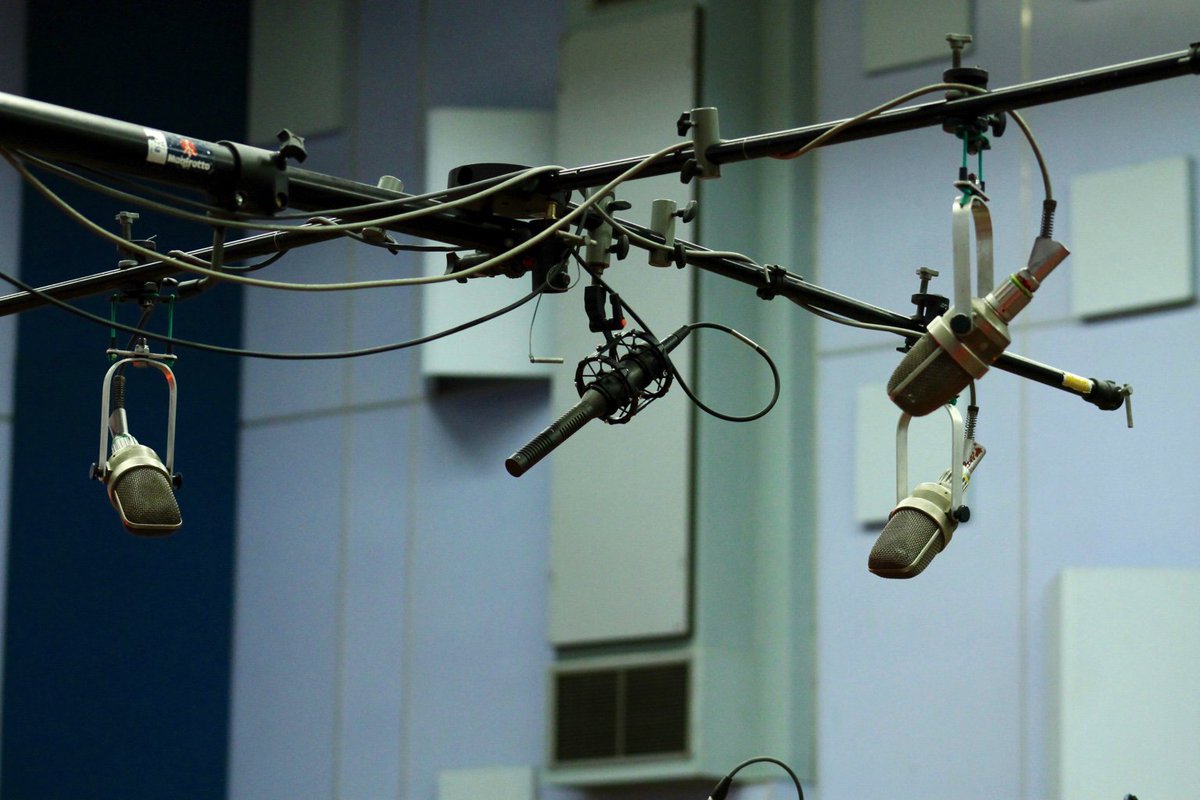
Three Neumann M50s on a Decca Tree bar
A group of good string players will dynamically balance with each other as they play, requiring little mixing or automation on your part. Room mics are commonly placed either above and in front of the ensemble, as they would likely be in a concert hall, or else directly in front of the group. Miking from above can yield a particularly roomy and “open” recording when the ceiling is high enough. Placing mics directly in front of the players gives a perspective similar to hearing the performance live.
5. Use Close Placements for Flexibility
When recording multiple string players with only a spaced placement, there’s no way to simply turn up one instrument while mixing. That’s why (even with a good sounding room) spot mics (close placements) can give you greater flexibility during mixing. In addition to added flexibility, using both close and spacious placements gives you the ability to blend multiple placements for a fuller and more nuanced tone.
Keep in mind that even with “close” mic placements on strings, it’s common to have mics as far as a foot or more away from the instrument being recorded. This is especially true if a single close placement on one player is all your setup will allow. In my most minimal string recording setups, I will typically use a single mic about two feet away from the instrument.
6. Consider the Angle
The most common close mic placement on string instruments is to have a mic pointed at the strings, more or less right where the bow makes contact with them — just above the bridge. This placement will be crisp and precise, with lots of articulation. On the other hand, it also tends to be where we get the most harsh string tone, especially with violin.
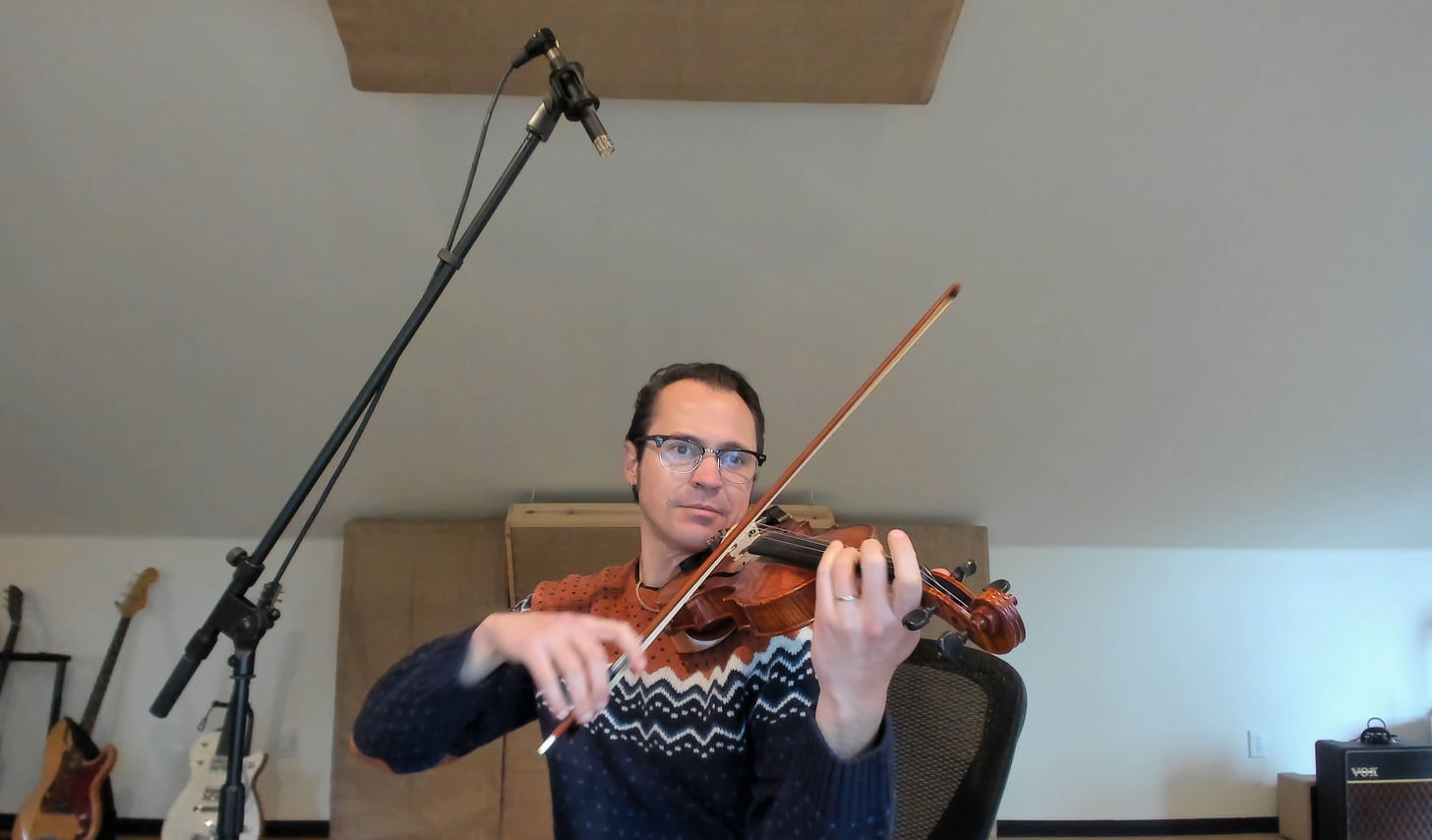
Yours truly, recording violin at my desk with a vanilla “above the bridge” placement
Though the “mic pointed above the bridge” placement is arguably the standard, it might not always be the right placement. When recording solo violin, I often like a single (potentially omnidirectional) mic, placed a few feet in front of the scroll — it sounds open, natural and lacks some of the harshness of pointing the mic right at the bow on the strings. The fiddle in the example below was recorded this way, with a single omnidirectional mic a few feet away from the scroll. It gives the fiddle a natural sound that brings in lots of the character of the room:
Try having the musician play their part as you gradually move the microphone away from them, listening on headphones as you do. Listen for a “sweet spot” where the sound is balanced, and stop there.
Some recordists will use “under-head” placements with violin as well, positioning a mic below the instrument to capture a darker sound that can add fullness when blending multiple mics. Some also like pointing mics at the body or f-holes of larger string instruments, though I tend to find those placements too muddy to be useful.
As always, keep in mind that more mics will require negotiating the phase relationship between them. I tend to prefer a single well-chosen placement as often as not. Sure, you will often see photos of large studio string sessions where dozens of mics might be in use, but that does not mean that you need to have that level of complexity in your string recordings to get a great sound!
7. Double Parts, Triple Them or More
Remember the earlier tip about having a sense of the size of the string group you’re looking for? This is where that really comes into play. Recording giant string groups isn’t always (…or usually… or maybe ever) an option. In fact, it’s very common for a single player to record an entire string arrangement by themself — I do it all the time!
Our ears are pretty used to the sound of a single string part being replicated by several players or several overdubbed takes. It’s pretty common to hear each “voice” in a string arrangement reproduced two or three times in a recording. Tighter string arrangements — think string quartets — won’t call for this approach. But if you’re adding strings to a pop song, expect to double or triple track each part in the arrangement.
Bonus: Double Violin Lines an Octave Down
In addition to simply doubling string parts, it can be particularly helpful to add an extra double of high violin parts played an octave below the original. Doing this accomplishes a few things: it adds fullness and richness to a part that might otherwise read as “shrill,” it helps create the sound of a much larger string ensemble and (maybe most importantly), it gives the players a chance to play the same notes in a register where it’s easier to play in tune.
8. Move Players Around the Room for Overdubs
Imagine a common setup for a string session: one or two players are performing a multi-part string arrangement. For practical reasons, a typical approach to doing this is to set up one mic and have them do their parts as a series of overdubs. If the goal is for them to sound like a larger group, there’s an easy way to add realism to the recording: with each successive double, have them move around just a bit in the room.
Let’s say one player is recording a two-part arrangement, with each “voice” triple tracked. Set up a close mic, and have them play the main take for the first part. When they go to double it, have them take a step back or to the side — just far enough that they are now where a second player would be positioned to record live with the same mic. When they do the tripled take, have them take another step, even farther. Each successive take will introduce more room into the recording, and add the perspective that our “group” is larger than it actually is. Repeat that process for the other voices — start with a crisp take right under the mic, and then move outward from there.
9. Layer in Sampled Strings Below the Live Ones
This last tip is maybe more about mixing strings, but it’s a good one to keep in mind as an alternative to recording a string part a dozen times in the hope of mimicking the sound of an orchestral string section (which is a pain, for obvious reasons). If a big, cinematic string sound is what you’re after, but you only have a small group to work with, try this: record live strings, and combine those recordings with the same part played with a sample library.
Blend the two to the “sweet spot” that sounds right for your recording. For best results, unify them with the same reverb and buss processing. In the example below, I started with a string part that had the sound of a tight chamber group — three violins, the one on the right pitched down an octave, all recorded with a small diaphragm condenser about two feet above the bridge. I blended in some sampled strings via Spitfire’s Albion Colossus for a bigger, fuller sound.
Here’s the live strings:
…and the same part with samples blended underneath:
When the samples are blended in subtly, it has the effect of filling out the part without losing the feel of the live strings.
Conclusion
Whether you’re recording a standalone string piece or adding a string arrangement to a song, the key to a great string sound is usually to let the players do their thing and capture it as naturally as you can. With the right mics placed the right way in a great sounding room, the players will do the heavy lifting for you — bringing out the expressive, colorful qualities that make string parts so exciting.






